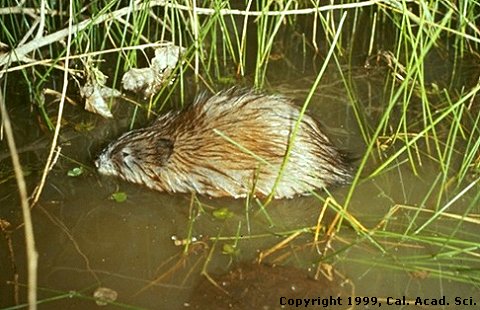


Ondatra zibethicus. Photographer: Lloyd Glenn Engles. Fresno County, CA. Copyright © 1999 California Academy of Sciences.
Generally, muskrats are nocturnal with some crepuscular (twilight) activity (Walker, 1983). They are territorial and are not very tolerant towards others of their own species, especially when there's a scarcity of food. They tend to live alone or with a mate in their dens. Muskrats are usually very clean animals. They spend a great deal of time maintaining their fur, and they tend to have designated areas for defecation in or around their dens. Population density is a very influential factor that affects muskrat behavior. When populations are high, competition is intense during the weaning period, when older young are known to eat the newborns (Perry, 1982).
Perry, H.R. 1982. Wild Mammals of North America: Biology, Management, and Economics. The John Hopkins University Press, Baltimore, 300 pp.
Walker, E.P. 1983. Mammals of the World (4th edition). The John Hopkins University Press, Baltimore, 552 pp.
Heather Jasso, March 2000.
Last Update: 21 Jul 2009